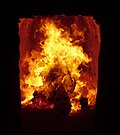Cremation
Cremation is a method of final disposition of a dead body through burning (combustion). Cremation may serve as a funeral or post-funeral rite and as an alternative to the burial or interment of an intact dead body. In some countries, including India and Nepal, cremation on an open-air pyre is an ancient tradition. Starting in the 19th century, cremation was introduced or reintroduced into other parts of the world. In modern times, cremation is commonly carried out with a closed furnace (cremator), at a funeral home, or a crematorium.
Process[edit]
Cremation involves the incineration of the body at a temperature of 800 to 1000 degrees Celsius. The intense heat helps reduce the body to its basic elements and dried bone fragments. The process takes place in a cremation chamber, also known as a retort, of a crematory. The remains, known as cremains, are not ashes in the usual sense, but rather dried bone fragments that have been pulverized in a device called a cremulator.
History[edit]
Cremation dates from at least 20,000 years ago in the archaeological record, with the Mungo Lady, the remains of a partly cremated body found at Lake Mungo, Australia. Alternative death rituals emphasizing one method of disposal of a body—inhumation (burial), cremation, or exposure—have gone through periods of preference throughout history.
Religious views[edit]
The act of cremation is considered sacred in some religions such as Hinduism, Jainism, and Buddhism while it is frowned upon in others like Islam and Judaism. The Catholic Church lifted its ban on cremation in 1963 and now allows for the practice, although it prefers burial.
Environmental impact[edit]
Cremation uses fewer resources than other forms of disposition, and the ashes can be returned to the earth in a number of environmentally friendly ways. However, the process does release greenhouse gases, and there is ongoing research into more sustainable methods of cremation.
See also[edit]
References[edit]
<references />
Ad. Transform your life with W8MD's Budget GLP-1 injections from $75


W8MD offers a medical weight loss program to lose weight in Philadelphia. Our physician-supervised medical weight loss provides:
- Weight loss injections in NYC (generic and brand names):
- Zepbound / Mounjaro, Wegovy / Ozempic, Saxenda
- Most insurances accepted or discounted self-pay rates. We will obtain insurance prior authorizations if needed.
- Generic GLP1 weight loss injections from $75 for the starting dose.
- Also offer prescription weight loss medications including Phentermine, Qsymia, Diethylpropion, Contrave etc.
NYC weight loss doctor appointmentsNYC weight loss doctor appointments
Start your NYC weight loss journey today at our NYC medical weight loss and Philadelphia medical weight loss clinics.
- Call 718-946-5500 to lose weight in NYC or for medical weight loss in Philadelphia 215-676-2334.
- Tags:NYC medical weight loss, Philadelphia lose weight Zepbound NYC, Budget GLP1 weight loss injections, Wegovy Philadelphia, Wegovy NYC, Philadelphia medical weight loss, Brookly weight loss and Wegovy NYC
|
WikiMD's Wellness Encyclopedia |
| Let Food Be Thy Medicine Medicine Thy Food - Hippocrates |
Medical Disclaimer: WikiMD is not a substitute for professional medical advice. The information on WikiMD is provided as an information resource only, may be incorrect, outdated or misleading, and is not to be used or relied on for any diagnostic or treatment purposes. Please consult your health care provider before making any healthcare decisions or for guidance about a specific medical condition. WikiMD expressly disclaims responsibility, and shall have no liability, for any damages, loss, injury, or liability whatsoever suffered as a result of your reliance on the information contained in this site. By visiting this site you agree to the foregoing terms and conditions, which may from time to time be changed or supplemented by WikiMD. If you do not agree to the foregoing terms and conditions, you should not enter or use this site. See full disclaimer.
Credits:Most images are courtesy of Wikimedia commons, and templates, categories Wikipedia, licensed under CC BY SA or similar.
Translate this page: - East Asian
中文,
日本,
한국어,
South Asian
हिन्दी,
தமிழ்,
తెలుగు,
Urdu,
ಕನ್ನಡ,
Southeast Asian
Indonesian,
Vietnamese,
Thai,
မြန်မာဘာသာ,
বাংলা
European
español,
Deutsch,
français,
Greek,
português do Brasil,
polski,
română,
русский,
Nederlands,
norsk,
svenska,
suomi,
Italian
Middle Eastern & African
عربى,
Turkish,
Persian,
Hebrew,
Afrikaans,
isiZulu,
Kiswahili,
Other
Bulgarian,
Hungarian,
Czech,
Swedish,
മലയാളം,
मराठी,
ਪੰਜਾਬੀ,
ગુજરાતી,
Portuguese,
Ukrainian












